
..........................................................................................................................................................................................................
rapha explore range, insulated goose-down jacket

there's something about thursday that apparently makes it the day on which to target new stuff. though no longer a regular reader, the comic, otherwise known as cycling weekly has long made use of the fourth day of the week to issue its latest publication. at one time in the distant past, in a clever pastiche of the football/soccer magazine 'when saturday comes', the comic would feature adverts with vintage photos of public schoolboys all crowding round one fortunate fellow holding a colour copy of the magazine. the heading stated 'when thursday comes'.

it's also the day favoured by channel e4 when introducing new series of 'the big bang theory' and other comedies, invariably stringing together three or four in a (successful) attempt to have us settle down in front of the tv rather than do something else instead. and it may not have escaped your attention that new book releases most often take place on thursdays, all across the publishing world, for no particular reason that i can think of.

and it was also the day of the week when rapha regularly published a new instalment of the late-lamented, north-american rapha continental. the exciting and well-documented exploits of daniel wakefield pasley, jeremy dunn et al as they cycled along the road less travelled, exploring many a hitherto unheard of gravel route across the united states, pretty much always surfaced on rapha.cc on a thursday and i'm not ashamed to say that i eagerly awaited those stories, images and movies. because, though it might be thought a tad obvious to mention, that's the sort of cycling most of us would like to undertake. a group of like-minded individuals, in this case all aboard hand-built steel bicycles, equipped with pink chris king componentry, staying off the beaten track, enjoying the camaraderie and showing rapha apparel to very good effect.

though i have no inside information to make an official connection between the continental and rapha's brevet, range, it can't be entirely coincidental that the two appear to have similar aims, except the latter seems intent on providing the wherewithal to travel those less-travelled roads, particularly for those who are bereft of motorised backup. for the continental were always shadowed by an accompanying mini-bus, initially harbouring not only the bicycles on a roof-rack, but all manner of accoutrements inside.
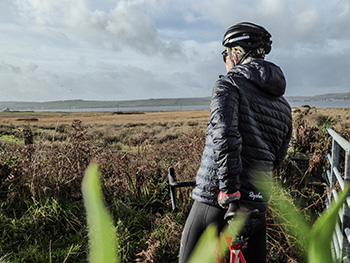
brevet, on the other hand, a range that has partially morphed into the explore collection, seems geared (if you'll pardon the pun) more towards a degree of self-sufficiency, featuring as it does, the necessary bags for bikepacking, the modern, funky successor to plain old touring. and given that such is the case, no longer is there the option of hiding in the van, 'til the weather clears long enough to pitch a tent or dig a hole in the ground. that, i'm sure you'll agree, makes it something of a necessity to be wearing a jacket that offers unparalleled 'cosy and warm', yet adds but scant grammes to the bikepacked luggage.
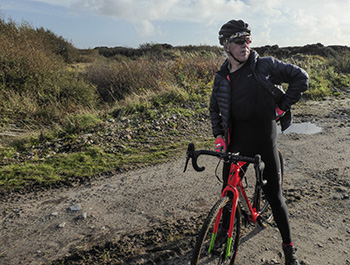
that's sort of where rapha's latest down-filled jacket fits the bill. though the brevet range previously featured an insulated jacket, quite frankly, it was nothing like this latest offering to the intrepid explorer. featuring goose down held in place within a series of separately sewn compartments, the jacket weighs almost nothing at all. attached to the coat-hook loop at the collar was a scarily small stuff-sack into which, believe it or not, the entire jacket, replete with hood, was able to fit. almost worth the price of admission itself.

it's a jacket that lends itself to both on and off-the-bike wear; let's face it, when you've finished exploring the hinterlands, or, as in jake stangel's excellent accompanying photos, you have need of travelling on a calmac ferry, this is the very garment that will allow you to steer clear of the cafeteria and watch any following porpoises from even the most exposed part of the deck.
there are two, zipped hand pockets just where you'd expect hand pockets to be, while on the pink-lined inner surface there are a further two open pockets into which wallets, phones, sunglasses, spare socks and the detached hood might reasonably be placed. should that calmac ferry be heading into the wind, the detachable hood will shelter your ears even when you're still wearing a helmet.
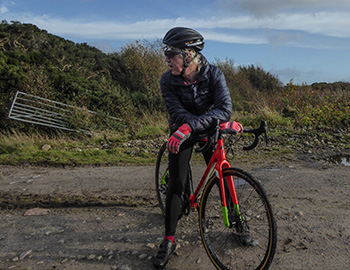
i'm none too sure as to just what sort of ambient temperature might be viewed as disfavourable, given my somewhat exposed residence, but though i rode the road very often travelled, in windchill of nine degrees celcius, wearing but a rapha technical t-shirt neath the jacket's cosiness, i was verging on being too hot. in fact, so far i have found no necessity to wear anything more substantial than the above mentioned t-shirt or a merino baselayer. should the temperature drop further (which it is forecast to do by next weekend), i think it highly likely that a long-sleeve baselayer will suffice.

for the more technical approach, the hang tag accompanying the jacket rates its fill power as 850, a measurement relating to the ability of the goose down to regain its original volume after being compressed whether during shipping, storage, or in general use. the maximum figure is apparently 900, so this stuff is pretty ginger peachy. the down is guaranteed fluorocarbon free, water resistant and bluesign approved. the latter is, apparently, the 'everest of approvals in manufacturing', a system designed to offer a solution for sustainable textile production, eliminating any and all harmful substances from the beginning of the manuacturing process. let's face it, if you're intent on exploring the great outdoors on a bicycle, surely an ethical approach is one that you'd prefer to abide by?
and should you be inclined to investigate further, the same hang tag features the goose down lot number that can be tracked via trackmydown.com. the down filling in the review garment was apparently 100% sourced from central europe and processed in los angeles, california. though i have so far managed only to get the jacket midly damp, rapha assure that it offers sufficient water resistance to maintain warmth even under the most extreme conditions you're likely to encounter.
fortunately, however, i don't own a tent; any continental style brevetting i might undertake would currently need to feature a hotel room at the beginning and end. happily, it's a jacket that would scarcely look out of place in the lobby.
rapha's down jacket is available in dark navy, dark green or black in sizes xxs to xxl. retail price is £220. | rapha down jacket
monday 22 october 2018
 ..........................................................................................................................................................................................................
..........................................................................................................................................................................................................rich mitch 'legends' takenotebook
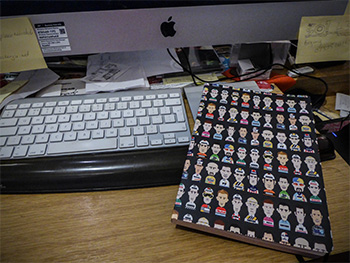
the local branch of the supposedly scottish bank in which all my money is stored, was fortunate to have escaped the recent round of closures. this has left a number of rural locations north of the border without any physical bank whatsoever. yet despite this parlous state of affairs, the staff seem just a tad too keen to persuade me to adopt their digital banking service. almost everyone i know, including mrs washingmachinepost, has an app on their phones allowing the paying of bills, transferring of money between accounts and no doubt many other services of which i remain oblivious.
i have my reasons.
firstly, i find it decidedly odd that any employee of a bank would proselytise that which might ultimately make them redundant. i am more than happy to have the girl behind the counter inform me as to my current balance, transfer money to another account and change large denomination notes into more practical amounts. for as one who, by my own admission, is none too good with numbers, i seriously doubt that i could make it through the year without messing up somewhere along the line. that and the fact that i am still one of only two people in the world bereft of a mobile phone, a situation that i do not see altering in the foreseeable future.
since the 2007 advent of apple's iphone, the phrase 'there's an app for that' has become ever more omnipresent, with seemingly very few factors in modern life that cannot be handled by a smartphone. i recall a visit to an early edition of 'bespoked bristol' where friends of mine had to park their car some distance from the venue because all immediate parking required payment by smartphone app and, at that time, none of them possessed such a device.

meantime, i am not only well aware of my luddite tendencies in this respect (not too keen on electric gear systems either, come to that), but i've no real desire to change my ways, simply to make life easier for the powers that proffer services i might need to use. like the banks, for instance. however, just to offer a massive contradiction to the above, my ipod touch, used mostly to play mel lewis sextet and septet recordings while i wash the teatime dishes, harbours a convenient reminder application of which i have made extensive use. whether my memory is actually struggling, or i am simply bombarded with more information than i can easily process, i know not.
but whatever it might be, my ipod will offer a suitable reminder of what needs to be done and when.
for that is the only downside i can find to the latest takenotebooks rich mitch legends edition. those 96, lined pages refuse to ping and tell me what it is i'm supposed to do. which is why i have made use of its pragmatism for other, useful purposes and not as a diary. for instance, when working between three separate pieces of adobe software, i frequently have need of maintaining the same cmyk numbers, which have usually been scavenged from elsewhere. if you're anything like me, work rarely proceeds in an organised manner; i'm eternally guilty of jumping from one project to the next without rhyme nor reason. thus, i've usually scribbled the relevant numbers, pantone swatches and filter settings on scraps of paper or post-it notes.
none of which can be found the following day and even if they are, i've forgotten to which project they refer. that's right when you need a rich mitch takenotebook. because those 96 lined pages have no need of a battery, no need of recharging and do not suffer from 'sleep mode'. and it's very hard to accidentally delete anything.
but from whence came the association between one of the country's finest illustrators and folks who offer books of lined notepaper. i asked ian at takenotebooks...

" When we started developing our notebook business, I began to create notebook cover designs, but the main aim of the company was create a platform from which like-minded designers could design notebooks without risk, and to use the collective social media 'voice' to promote the work. Instagram is perfect for this. Having been on social media for a few years, and as a fellow cyclist and designer, it wasn't long before I was drawn to Richard's work. So I approached him to ask if he wanted to design some notebooks, and to showcase his LEGENDS pattern. He is a brilliant illustrator, and his work is uniquely 'Rich' - a visual signature. We felt that our quality product and his style would be a great selling collaboration."
but i hear one or two of you murmuring about the cover remaining partially open after frequent use. i'm glad you mentioned that, because this cycling legends decorated note book features an elastic strap fastened to the back cover, allowing the front to be securely closed and not become out of sorts, when stuffed into a rucksack or computer bag. and though the cover could probably display pretty much anything at all, we are cyclists, keen to remind ourselves and others, that there's more to life than writing cmyk numbers and distillery managers' mobile phone numbers on lined notepaper with rounded corners. but when there isn't, we want to be reminded of our cycling heritage and have colleagues ask us to identify the caricatures on the cover. because we're unbearably smug in that way.
you know i'm write.
takenotebooks rich mitch edition
sunday 21 october 2018
 ..........................................................................................................................................................................................................
..........................................................................................................................................................................................................write on

though ostensibly formed for apparently nefarious purposes, i believe more than one episode of 'midsomer murders' has featured a 'book club', always women and usually a society in which one or two of its members meet a disturbing end. book clubs exist in all strains of society, again, predominantly consisting of female members and mostly choosing works of fiction, whether the classics, crime or romance. though it maybe says more about me than i'd like to think, i don't actually know of any gents' book clubs.

it's a societal thing that has not ignored islay, at least once in the recent past, where a village-based book club grew into a book festival, initially staying put in the selfsame village, but under new management (so to speak), a couple of years ago it became the islay book festival. i am not a habitual reader of fiction, if for no other reason than my days are well-filled with cycling literature for review in these very pixels. i'd be fibbing if i said i could recall when i last read a work of fiction; if push ever comes to shove, that's my excuse for having not attended any of these events.
but, without wishing to dismiss an entire genre of writing with one fell swoop, fiction is 'simply' a case of making stuff up. granted, it has to be legible, literate and well composed stuff, but there's no real need (as far as i can see), to base any of the narrative in real fact. non-fiction, on the other hand, seems a tad more onerous; days, hours, weeks, months or even years of research and interviews, a pressing need to have all one's chronologies in the right order and no end of other distractions that need to be appraised, before deadlines (self-imposed and publisher led) hang over the intrepid author's head like the sword of damocles.
however, unlike my saturday morning bike ride, these things are rarely, if ever, undertaken alone. for starters, there is an appreciable difference between the expectant author clamouring for an agreement from any publisher willing to offer them a lifeline and the bona-fide publisher with a commercially curated idea on the lookout for an author with the capability to turn that idea into a saleable commodity. i am insufficiently well informed to know whether a 'meeting of like minds' is a commonality, but such seems to have been the case with the recently released and reviewed, bluetrain/rapha editions publication 'queens of pain'. though the name on the cover is that of isabel best, that hides a wealth of interest and intrigue behind the three cover options.

for starters, what prompted isabel to approach this subject matter?
"The idea for the book actually came from Taz (Darling) and Guy (Andrews). I was talking to them about quite a different idea, (nothing to do with women's cycling), and they asked if I'd be interested in writing what has become 'Queens of Pain'.
"For a while, I had been wanting to write a book about female champions, which I'd been told would be a hard sell, etc, etc., so I was really excited when Bluetrain asked if I'd be interested in this Rapha Editions publication."
the book's editor, taz darling concurred. "As with Andy McGrath's 'Tom Simpson', the concept for Queens of Pain was already fully formed (in my head at least) and Rapha were keen to publish it. We all agreed that it was a 'response', if you like, to their ten-year old publication 'Kings of Pain'.
"While researching who we could commission to write it, Isabel approached us about a completely different idea. She came across as someone with the passion and enthusiasm to be involved, so I suggested the idea to her. She 'got it' straight away. I've never had any doubt that I made the right choice and she has done a terrific job, for which I hope she will receive deserved recognition."
while there's no doubt that, on completion of one book, a professional author will probably immediately look at what might come next, publishers and editors are likely no different. but though isabel, in common with many other sports writers, could well be looking towards an entirely different athletic discipline, as a publisher seemingly firmly entrenched in the velocipedinal milieu, bluetrain likely have cycling uppermost in mind and spreadsheet. given the subject matter of isabel's 'queens of pain', did taz find her editorial approach to this book differed from that practised on others she's edited?

"It was similar to my approach to Andy McGrath's 'Tom Simpson' in that Guy and I knew exactly what we wanted to create, but needed to find the right author to share our passion for the subject. As with TS, where Andy did such a great job of researching, interviewing and writing, Isabel was untiring in her approach. Her energy for research, her attention to detail and her determination to pursue the story is remarkable.
"For me the most interesting part was offering both Isabel and Andy the opportunity to write their first books. It concerns me that traditional publishers are not willing to support or encourage new talent; that makes no creative sense. The result is usually just 'more of the same', unless you take risks."
i doubt that there's a secret formula, instigation of which will always result in a publication guaranteed to receive plaudits from the book buying public, independent of the subject matter under discussion. but i'd imagine that there's an increased chance of success, however, you choose to measure it, if, in the process of reading this hypothetical publication, the reader is afforded the opportunity to discover hitherto unknown facts. though i've reviewed one or two books on bicycle repairs, in those cases, it's more about the delivery than learning that my bicycle features a bottom bracket.
a major point of interest fostered by isabel's 'queens of pain' was reading about riders of whom i had not previously heard, a state of affairs i'm sure i share with others. bearing this relative anonymity in mind, was her research made any more difficult than she'd expected?
"Before I really got my teeth into the project, I suspect my knowledge was similar to yours. I initially thought it would be a much shorter book and that I might be scraping around for material. I even asked Taz if we could have micro-chapters with just a couple of paragraphs, where the pictures were great but the story more of a mystery. In the end, I think the final manuscript was more than twice as long as what had been originally discussed.
 "So yes and no.
"So yes and no.
"Of course, the lack of recognition made research difficult. Sometimes I'd start out with random scraps of information: a compelling photograph or a one-line Wikipedia entry. Often all I had to go on was someone's name in a list of world champions. I scoured newspaper archives and tried to contact riders and descendants. Sometimes there was very little press coverage, so in some places the book has an oral history quality to it, since I had to rely on what riders told me.
"On other occasions I got lucky, where riders kept scrapbooks of their cuttings and their descendants still have them. I benefitted from the work of specialists and enthusiasts and I explored stories on blogs or self-published books. I also spent a lot of time gazing at pictures and watching Pathé newsreels trying to immerse myself in the worlds of those riders.
"To give you just one example, I had a total headache trying to track down any Russian riders. Obviously it doesn't help that I don't speak Russian, but the sports bodies and local councils where riders lived, seemed completely indifferent. Ultimately, a Russian acquaintance went on a mission for me, intermittently sending me emails about how rubbish her compatriots were. Amazingly she finally put me in touch with a local historian from Tula, who passed on an email address for the daughter of Lubow Kotchetova, the first world champion in the 3,000m individual pursuit.
"We ended up having a series of epic Skype calls where she talked in great detail about her mother's extraordinary life, as well as those of her colleagues. Lubow's story was incredible. As a young girl, she survived the siege of Leningrad, and as a rider she came back from a crash which should have killed her, eventually becoming world champion."
the contents page of 'queens of pain' informs the reader that they can expect to read the career stories of two-dozen female riders. and as mentioned above, more than just a few of them will be wholly unknown to the majority of us. it's also unlikely that history has given us only 24 women riders of whom special note should be taken, so, in her editorial capacity, did taz suggest any of those included, or did isabel have all her ducks in a row before commencing?

"The hardest choices were who to exclude and what the time period cut-off point should be. It came down to space (as ever with a book) because there are only so many stories you can do justice to in one volume. We chose to concentrate on the largely forgotten stories rather than the more recent ones with more information, footage or imagery available. I felt duty bound to deliver these stories in particular before they are lost, and to use the space well to explore the richness of each. We all got to include our favourites but then Isabel uncovered such fantastic detail and so many great new stories that our favourites changed along the way too."
few amongst the surprisingly large library of cycling books arrive bereft of illustration. when discussing the lives and feats of more obscure personalities, i'd imagine it's almost compulsory that they are accompanied by relevant illustrations. in this day of facebook, instagram, flickr and the like, finding appropriate images is probably a far less onerous task, but the first rider featured in 'queens of pain' raced 129 times in 1895, an era not noted for its plethora of attendant photography. i asked isabel if photographic records of the cyclists weren't somewhat thin on the ground?
"We found a lot of great images from riders' archives. They were often pictures published in magazines that have long since ceased publication and whose archives are dispersed, but sometimes the editor or photographer would send prints to the riders as a nice memento. This was common in men's cycling in the 1950s and 60s, since photographers wanted to nurture great relationships with the riders. There are pictures in Millie Robinson's archive, held by her nephew, that I'm almost certain were taken by the great cycling journalist and magazine editor, Jock Wadley. Taz could tell you more about the picture research for the book since she really drove this, but I know that another problem is the disappearance of great photo agencies in this age of Instagram and Pinterest and a universal expectation to get pictures for free these days. That certainly didn't help."
one of the book's major features has to be the decision to creatively print the imagery using five spot colours, none of which were black. colour plates are more usually printed with process cmyk. i asked taz what prompted this 'non-standard' choice of reproduction?
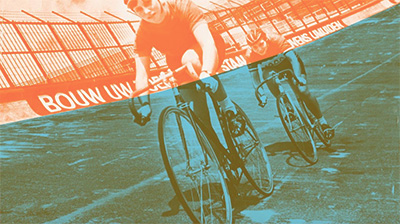
"There is nothing 'standard' about the women's stories, so to me it would have been insulting to collect them in an ugly book. We wanted to represent the historic images in a more contemporary way, creating an equality amongst the stories, irrespective of their time in history. A Pantone spot colour (rather than a CMYK mix) remains a constant, no matter the machinery or process surrounding it - rather like our heroines. We were fortunate enough to have commissioned Melanie Mues to work on the design. Her work is very sophisticated which is what this book cried out for, simply to do it justice. Melanie is incredibly creative in her approach and worked passionately on the colour and treatment of all the images, drawing from the text and being inspired by each individual character. And I need also to mention the wonderful Jo. She helped uncover some of the great imagery including the old soviet era images which sit in filing cabinets in Russia still. I think it is a strong, bold and honest book. All of the women Isabel wrote about have a resonance in contemporary cycling in one way or another. I knew I didn't want the images to 'trap' the protagonists in history and separate them from 'now'; the colour treatment allows for a consistent look in the timeline and so it feels less like 'just a history book."
was isabel complicit in this choice of colour reproduction? "I wasn't that closely involved in the design process, although I knew from the start that Taz had ambitions to experiment and rethink what a cycling book might look like. I think Mel Mues has done a brilliant job with the design, uniting so many diverse images from very different eras and giving it all a bit of a punkish attitude."
i have known several authors who rued the day they met their book's editor and one in particular who was subjected to three different individuals over the course of one project. this was allegedly due to endless disagreements over points of view, though i have my doubts over who was really to blame for the situation. i'm not sure who'd be sure to have the final say, but in order to produce a successful book, it would be ideal if both got along just ginger peachy, thank you very much. both singing from the same hymn sheet, so to speak.

were taz and isabel possessed of the same ideals? was this a labour of love between editor and author, or did the book more or less produce itself? "I think it was a labour of love between the whole team who worked on it." said taz. "Mel worked so passionately to produce a visual representation of the incredible stories that Isabel had unearthed and put together. Anja, the sub-editor, worked tirelessly on keeping the words to scale; there was so much we had to leave out and keeping the stories full and punchy was a challenge all-round. Guy and I just steered the ship. For me, this is a very important subject and the book is certainly not some exercise in tokenism. It says as much about where we are now in cycling, as to where we were then. And if I never get to make another book, I'd be so satisfied that I got to do this one."
finally, it's not unusual for a book to serve a dual purpose, even if one of those purposes might have been unintended at the original point of conception. each chapter in 'queens of pain' features a historical tenacity that truly deserves to be recorded for posterity, something brilliantly achieved here. but does isabel have hopes that her book becomes an inspiration for young, female, would-be cyclists of the 21st century?
"The quick answer to this is, yes, of course! I have three young daughters, so they were also very much at the back of my mind when writing the book. They're very keen readers, who love stories of all types, so sometimes I would talk about a rider who I was researching and see how they responded before starting to write.
"Naturally I'd love it if this book inspires them and others. Cycling is such a generous sport, one that anyone can do, whether you're just using the bike for weekend excursions, or you have an urge to be the fastest thing on two wheels. I also hope the book will be enjoyed as much by male readers as females.
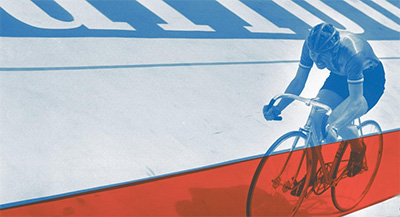 "Many of the women I spoke to never thought of themselves as 'female' riders; they were racing cyclists who happened to be women. One book which I think reflects this point of view and has certainly influenced me, is Tim Hilton's 'One More Kilometre and We're in the Showers'. I love that he mixes up women's and men's stories with little fanfare, like it's totally normal the women's stories should be included too. I'm just as inspired by Eileen Sheridan riding long and hard to break records as I am by Roger Walkowiak winning the Tour de France through pluck and determination. I don't see why men shouldn't be similarly inspired."
"Many of the women I spoke to never thought of themselves as 'female' riders; they were racing cyclists who happened to be women. One book which I think reflects this point of view and has certainly influenced me, is Tim Hilton's 'One More Kilometre and We're in the Showers'. I love that he mixes up women's and men's stories with little fanfare, like it's totally normal the women's stories should be included too. I'm just as inspired by Eileen Sheridan riding long and hard to break records as I am by Roger Walkowiak winning the Tour de France through pluck and determination. I don't see why men shouldn't be similarly inspired."
saturday 20 october 2018
 ..........................................................................................................................................................................................................
..........................................................................................................................................................................................................tread carefully

april fools day has, for the most part, worked quite well from my point of view. from a special edition rapha continental jersey with a white hoop on the right sleeve (because the americans drive on the wrong side of the road) to chris king's innovation of magnets replacing their medical-grade bearings, i have rather enjoyed inventing utter nonsense just daft enough to be believable. however, one of my arguably less successful ploys revolved around one tyre company's naming of their four seasons rubber, leading to some notably poor photoshop renditions of a tyre that purported to actually self-alter the tread, depending on the time of year.

the initial idea seemed perfectly sound, it was mostly the deployment that left a bit to be desired.
but the notion of cyclists changing tyres as a result of changes in road or weather conditions is one that has surfaced infrequently, often influenced by the formula one chappies, who dive into the pits for a tyre stop, if the driver ahead even sneezes. i have witnessed questions on cycling forums where newbies (i presume) have enquired as to whether world tour riders ever change tyres mid-race for reasons other than punctures. it's not entirely unheard of in cyclocross circles, depending on course conditions, but a process that usually takes place during a complete bike change. since bike changes in 'cross are pretty much part of the scene, it's not a practice of which much note is taken.
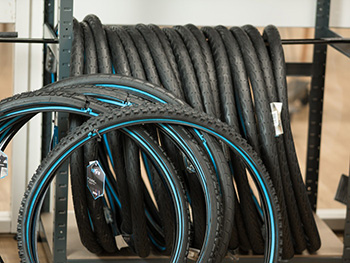
but, racing aside, how many of us would awaken one less than fine morning and opt to switch to a wider, more rugged tyre for the commute to work, simply because it was raining, snowing or blowing a gale. for those well-supplied with spare wheels, that might be an option, but i think most of us would stick with what we have. i could be well-wide of the mark, but i can't think of any of my velocipedinal acquaintances who harbour a wardrobe of differently shod hoops to suit the prevaling weather conditions.
none of this, however, mitigates against thinking about so doing, particularly if domiciled in a location regularly subject to widely varying climatic conditions. but if only there was a more practical and economic alternative.

in one of those 'careful what you wish for' moments, i don't mind admitting that i at first thought this a practical joke about seven months too early. currently well over-funded on kickstarter sits retyre one, an invention that claims to be the world's first zip-on bicycle tyre system. yes, you did indeed read that correctly. along the sidewalls of a relatively normal clincher tyre is one half of a zip, eagerly awaiting connection of the other half which forms the outer edges of a replacement tread.
consider wending your merry way for a further day's toil and strife, when overtaken by an unexpected blizzard. those smooth tyres on which you began your journey struggle manfully or womanfully to gain any sort of meaningful grip on the ever-deepening snow. always the boy scout, thankfully your pre-ride preparations had been to pack two chunkily treaded retyres in your backpack and 'tis now a matter of minutes before those slicks have been converted to the sort of rubber that matthew van der poel would give his karcher pressure washer for.
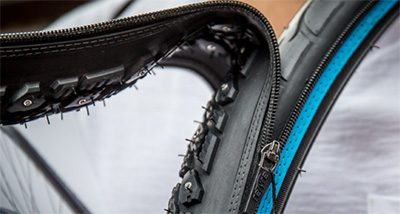
on the face of it, this sounds every bit as implausible as my four seasons tyre that morphed its memory rubber into a variety of treads, the difference being that this one actually seems to work. though all prices on the retyre kickstarter page are shown in dollars, the contradiction would perhaps be their trumpeting of a one million dollar eu grant (always assuming they mean the same as i think eu (european union?) to mean). and if they've been provided with that level of funding, it's hard to comprehend where kickstarter fits into the equation. however, for a pledge of $79 or more you will eventually receive two retyre one, modular tyres at the beginning of 2019.
i may scoff, and you may well have joined in my scoffing, but there's every likelihood it will be you and i who have potato and leek omelette on our faces when this turns out to be the next big thing.
retyre one kickstarter campaign
friday 19 october 2018
 ..........................................................................................................................................................................................................
..........................................................................................................................................................................................................queens of pain - legends and rebels of cycling. isabel best. bluetrain publishing/rapha editions softback. 240pp illus. £25

when my younger brother and i were mere teenagers, i managed to convince him, for no particular reason, that there was such a thing as a left-handed piano. it's the sort of annoying practical joke that is easy to believe; if paul mccartney, a noted south-paw, played a left-handed hofner violin bass guitar, would it not, tautologically speaking, make perfect sense that the same principles would apply to keyboards? of course, as far as i'm aware, there are no commercially available versions of this non-existent instrument, in much the same way that your local music store probably stocks very few, if any, left-handed guitars.
left-handed individuals are very much in the minority and in the past, it was a natural predilection that was actively discouraged. i know of several acquaintances for whom the act of learning to write was a great deal harder than for the rest of us, because of a teacher who simply wouldn't hear of such a thing. big business - in this case, fender, gibson, steinway, bosendorfer, et al - cater predominantly to the majority and their stockists do likewise. but that is surely not a situation that pertains to humanity as a whole? though i have not looked closely at any world population statistics, it seems not an unnatural assumption to figure that around 50% of the world is male and the other 50% female. give or take. yet the popularity of many an activity, sporting or otherwise, would seem to disavow the casual observer as to the veracity of my assumption.
for instance, i note that women in formula one motor-racing, until recently, seemed confined to standing glamorously alongside the motor cars, sheilding the drivers from the sun or rain. and even our own professional level cycling insists that the winner of any given stage of any race you care to mention is kissed on the cheeks by one or two podium girls. and far be it for me to admit to taking any pertinent notice of the golf world, but i'm unaware of copious television coverage of the women's game. again, until recently, there were a number of golf clubs that banned women from the often sumptuous facilities provided for the apparently 'superior' male golfers.
i know that, in the western world at least, this attitude towards women is in the process of change; things probably aren't as bad or as discriminatory as was once the case, but to use the word 'equality' still remains a bit of a misnomer. which is why this latest publication from bluetrain publishing/rapha editions, written by isabel best, is one that should be welcomed with open arms.
the title, 'queens of pain' is a reference to a 2014 publication from rapha, entitled 'kings of pain', one that featured many of the greats drawn from cycle racing's rich heritage, including fausto coppi, jacques anquetil, gino bartali etc. however, though cycle sport is notoriously dominated by the male of the species, isabel best has partially, yet effectively, redressed the balance by featuring two dozen riders the majority of which you will likely never have heard of. and if we assume that the greats of the male side of the equation had a hard life as 'convicts of the road', women who felt the compulsion to ride bicycles very fast, arguably had a far harder time of it.
"They would ride for 100 miles to take part in a 10-mile time trial and work 12-hour days, six days a week, travel on night trains so they could race on Sundays, then get the sleeper back for work on Monday morning."
the existence and persistence of the women included in 'queens of pain' is very much at odds with the 'expected' behaviour of the fairer sex. far more common would have been sewing bees, charity work, church coffee mornings and the like; what society expected and most often, what society got. dressing skimpily in shorts and jersey to ride a bicycle was most certainly frowned upon in certain 'respectable' quarters. yet even in the late 19th century, not long after the birth of the safety bicycle, a swedish girl then living in chicago, was able to make her mark on that particular corner of american society and stand out amongst her peers.
"Tillie (Anderson) not only stopped crashing, but improved with each day of practice [...] She went on to win the entire Six-day race. [...] That year she took part in eight Six-day races and won all but one."
the author has compiled an impressive coterie of female riders, illustrating the tenacity of many in the face of what could legitimately be described as adversity. there are the well-known riders such as alfonsina strada, eileen sheridan, beryl burton, connie carpenter-phinney and jeannie longo, but no less worthy are the hitherto unknowns: helene dutrieux, evelyn hamilton, margeurite wilson, valda unthank and many others. best should be praised not only for her research into the lives of these women cyclists, but for narratives that are every bit as compulsive as the tenacity of her subjects. her style does her and them, proud.
"There's a certain classic photograph of a racing cyclist from the 1920s. It is raining and the rider wears a mud-caked woollen jersey and shorts. A thousand yard stare issues from a face worn with the indescribable effort of a race just completed. [...] Our picture was taken... of a woman, the French Champion Suzanne Hudry. But that's probably all we'll ever know of her."
it is well that the author makes mention of a photograph, for the reproduction of those in the book is more than worthy of special mention. given that the majority are from the days prior to the advent of colour photography, in another, less adventurous publication, these would have been faithfully reproduced in monochrome. however, the editors at blue train eschewed such conventions, choosing not only to have the images printed with spot inks, as opposed to the more usual process colours, but the entire publication, including text, is devoid of black. several of the images, aside from the imposition of an attractive line-screen, have been subjected to the overprinting of a second colour atop the first.
according to blue train's, guy andrews, "The whole job was printed with five colours. There is no CMYK (cyan, magenta, yellow and black (key)) as we replaced them all with a spot colour, which is why the text is blue. There's no black either. Any overprinting then became a bit of a lottery. We had some ideas as to what would happen, but it was a bit suck it and see. It also made the images a bit more fun and kept a consistency through the book. Some of the (image) quality was variable as it spans around 100 years of racing.
"Our printers enjoyed it too, although it took them a day to clean the presses so they could get back to the next job."
treating the imagery in such a manner could be seen as somewhat trivial or superficial, but in my opinion, so doing has raised the book's presence to that of a desirable and treasurable object. allied with isabel best's praiseworthy endeavours, it makes 'queen's of pain' a publication that you ignore at your peril.
a book that will be deservedly talked about for many a long year.
queens of pain is released on friday 19 october
thursday 18 october 2018
 ..........................................................................................................................................................................................................
..........................................................................................................................................................................................................somewhere to hide

"so, if he won today, why isn't he wearing the yellow jersey?" "why have they let those riders get so far ahead? why are they riding so slowly? those other riders are going to catch them."
tell me you've never been asked those questions while watching a race on the telly box. it is undoubtedly an overused cliché to describe cycle racing as 'chess on two wheels', but more than ever, contemporary cycle racing depends greatly on pre-planned as well as ad-hoc strategies.

we can thank the likes of eurosport and itv4 for providing us with the opportunity to view these strategies as they are played out in real time. edited highlights of cycle races will provide a flavour of how the day went by, but watching from start to finish offers the chance to see which teams or riders had the right idea from the get go. naturally enough, one team's plans for the day can go horribly awry if another commences a contrary move a few kilometres earlier and that's without factoring in any mechanical difficulties or unfortunately timed punctures.
but you and i both know that it's not only the best laid plans of mice and men that bring you safely to the podium girls each day. though i would scarcely retrench from considering any one of the modern-day peloton to see the finish line well ahead of yours truly, even if they rode a shopping bike with a basket on the front, the efficiencies of modern velocipedinal technology still have their parts to play. eddy may have been happy to disenfranchise the opposition on lugged steel and downtube levers, but those opponents were, to a man, riding the same technology.

dave brailsford's legendary marginal gains, encompassed not only minute improvements in training programmes, but any technological advantage that might conceivably be gained through the use of specific componentry, frame materials and aerodynamics. though i have serious doubts as to whether electronic gear systems and hydraulic disc brakes can be counted upon to propel the pelotonese closer to victory, it's the notion of improved aerodynamics that seems keen to offer highly subjective gains.
placing an aerodynamically clad rider on an aero-frame in a wind-tunnel will, no doubt, provide a slew of numbers to prove potential marginal gains over a specified distance. however, conditions inside a wind-tunnel have not, so far as i'm aware, ever been classified by the met office with a name. in other words, testing in this manner provides an almost clinical approach to aerodynamics, free from the iniquities of severe crosswinds, driving rain, passing team cars and the legendary alleged downdraught of the tv helicopters. having attempted to ride deep-rim carbon wheels in a hebridean crosswind i am at least tangentially aware of that of which i speak.
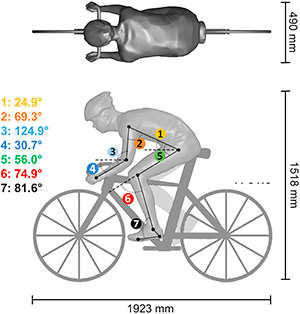
however, it appears that the practices of echeloning (is there such a word?) and hiding in the middle of a speeding peloton are not to be taken lightly. having watched many an early-season race where sheltering from the wind is part and parcel of the spectacle, an article in the journal of wind engineering and industrial aerodynamics has taken a far more specific and closer look at the forces at work on the not so average race peloton. validated by four differing wind tunnel campaigns and partcipation of 121 scale-model cyclists, using computational fluid dynamics (cfd), a number of european scientists have attempted to determine just how much shelter can be gained and which would be the most favourable spots in a speeding peloton to achieve such potential gains.

it is of slight concern that such a study was deemed necessary in the first place, other than as a purely academic exercise, but it would be naive of any amongst us to think that the results will be treated with the same level of cynicism as by yours truly. for some, if not all, directeurs sportifs, this will doubtless be treated as manna from heaven. yet, you do have to wonder if the research grant that made this all possible, wasn't perhaps simply spent weaving the emperor's new clothes. for instance, pronouncements such as...
"The results show that the drag of all cyclists in the peloton decreases compared to that of an isolated rider. In the mid-rear of the peloton it reduces down to 5%-10% that of an isolated rider."
...could hardly be described as groundbreaking. though i'm sure none of us could have quoted specific percentages, i'm sure we all know that surrounding ourselves with fellow cyclists into a headwind has a tendency to make pedalling a bit less onerous. one of the conclusions outlined in the study, states that current assumptions regarding drag reductions in pelotons are incorrect. however, these incorrect assumptions' equate to "...inside a tightly packed peloton with multiple rows of riders providing shelter, larger drag reductions can be expected." this effectively means that there is a 'sweet spot' within any raging peloton, though depending on its composition, speed and the terrain over which it travels, this might be a difficult spot to pinpoint.

and should it actually be possible so to do in real time, can all the top riders from twenty-two teams squeeze themselves into the same area? at the same time? i am still naive enough to consider cycle racing a sport, where, above mentioned technology notwithstanding, it is still a case of 'mano e mano' and may the best man win. i'm sure the scientists involved enjoyed their intellectual exercise and no doubt there's scarcely a team headquarters bereft of a spiral-bound copy next to the coffee machine, but i can't help thinking that quotes such as that listed below are just a few electronic gearchanges on the wrong side of the echelon.
"The philosophy of subconfiguration validation is to perform the validation on geometrical configurations that are a part of the actual configuration under study. If a given set of computational parameters (domain, grid, approximate form of governing equations, solver settings, etc) yields accurate and reliable results for the subconfigurations, it can reasonable be assumed that the same set of computational parameters will also yield accurate and reliable results for the actual configuration."
suddenly that garmin setup manual doesn't look quite so daunting after all.
new insights by computational fluid dynamics
thanks to richard peploe for pointing me in the direction of this study.
wednesday 17 october 2018
 ..........................................................................................................................................................................................................
..........................................................................................................................................................................................................endura fs260 pro-adrenaline race cape and waterproof 3/4 shorts

there has been much blasé discussion on the island in recent days regarding the weather and the heightended significance it seems to have attained. as we head from autumn into winter, we can but expect not only a consistent drop in temperature, but the onset of incoming wind and rain. as such, it has ever been this way; i recall my first year on the isle, watching the rapid approach of inclement weather across the loch. though it crept up in a rather ostentatious fashion, the knowledge that there was nowhere to hide and no escaping its onslaught, was a lesson well-learned at the time and one that has scarcely lessened over the intervening three decades.

however, though the weather itself has scarcely changed all that much, its public relations agency (otherwise known as the meteorological office) has substantially altered its approach. for instance, it has now become not only de rigeur to anthropomorphise any strong winds or weather systems, but to colour-in large sections of the map in either yellow or amber and issue a concomitant warming that this has been done. thus, what used to be just hebridean weather, now shares headlines with eastern america's hurricanes.
i might illustrate this point with reference to the recent 'storm callum'. the word 'storm' would tend to indicate a weather system that might readily cause structural damage, bringing to mind recollections of the opening monochrome sequence from 'the wizard of oz'. yet, during a weather forecast on the telly box, the weather girl was wont to announce that 'storm' callum was likely to bring gales or severe gales to the hebridean islands. though i am pedantic to a fault, if the winds are 'only' gale or severe galeforce, then it's not a storm.

meanwhile, island life continues at its regular modest pace.
following in the wake of callum was a lengthy tail, content to drop large quantities of precipitation upon a less than impressed population. just ask those living in wales. not wishing to look a gift storm in the mouth, i donned the latest pro-adrenaline waterproofs from livingston's endura, consisting of a barely opaque race cape and a pair of threequarter length overshorts. the adrenaline race cape is accessorised by a tiny stuff sack into which you'd scarcely believe that the cape could be stuffed (but it can) and is available in charcoal grey, white, fluoro-green or movistar blue (as reviewed. the shorts are in charcoal only.

the nomenclature defining the jacket as a race cape along with the accompanying stuff sack would rather classify the jacket as an item to be kept in a rear pocket (or team car) for what we might term 'emergency use'. though the overshorts fulfil a similar function, i'm none too sure just how practical it is to stop mid-ride and clothe oneself in such a manner. and oddly enough, though i wore the adrenaline threequarters over a pair of endura bib-threequarters, the former were a matter of a couple of centimetres shorter than the latter. additionally (and we'll say more about this later), the cuffs of the jacket are so purposely narrow, that it is well nigh impossible to wear them over the cuffs of your gloves.
i cannot deny that i gave both items from the adrenaline range a particularly hard time. i spent three hours in pretty much torrential and persistent rain, the end result of which was that i got very wet. in that sense, you might argue that both garments are surely less than worthy of your cash, but that could be just to miss the point. under normal circumstances, i'd be inclined to view both items as protection from intermittent and adverse elements, rather than those i'd don if expecting to spend all day in the rain. let's face it, if this £78 jacket could offer such long-term protection, why would endura bother offering their £200 mt500 waterproof jacket?
but i should point out that even if your gloves are waterproof, wearing them over the jacket cuffs only encourages the rain to seep inside, never to escape.

so, while i was sat in debbie's on a saturday lunchtime, creating a substantial swimming pool 'neath my chair, wearing a rather damp team movistar long-sleeve jersey, my inherent dampness was scarcely unexpected. in point of fact, for the first hour, to hour and a half, both race cape and threequarter shorts made a grand and valiant job of keeping rainwater on the outside. those shorts impersonated a rear mudguard remarkably well. but ultimately, the rain won; thin fabrics such as endura's exoshell20st can no longer perform at their best once the fabric becomes saturated, when the water is being delivered more quickly than it can be got rid of.
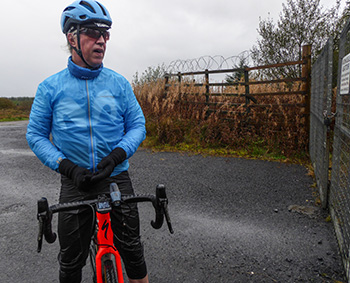
as such, this was something of an unfair equation. but to be honest, both cape and shorts performed better than i'd have expected. taped seams, a drop tail and front storm (gale?) flap on the cape and impressive stretch properties are all most welcome in the heat of battle. stuffed in a back pocket in case of heavy showers encountered en-route, they're the equal of the very best currently on the market. sadly, i'll likely never know how effective the adrenaline jacket is at offering a clear view of a race number.
endura's fs260 pro-adrenaline race cape ii is available in sizes from xs to xxl at a retail cost of £77.99. the pro adrenaline threequarters are available in small to xxl at a cost of £74.99.
fs260 adrenaline race cape | fs260 adrenaline waterproofs 3/4
tuesday 16 october 2018
 ..........................................................................................................................................................................................................
..........................................................................................................................................................................................................